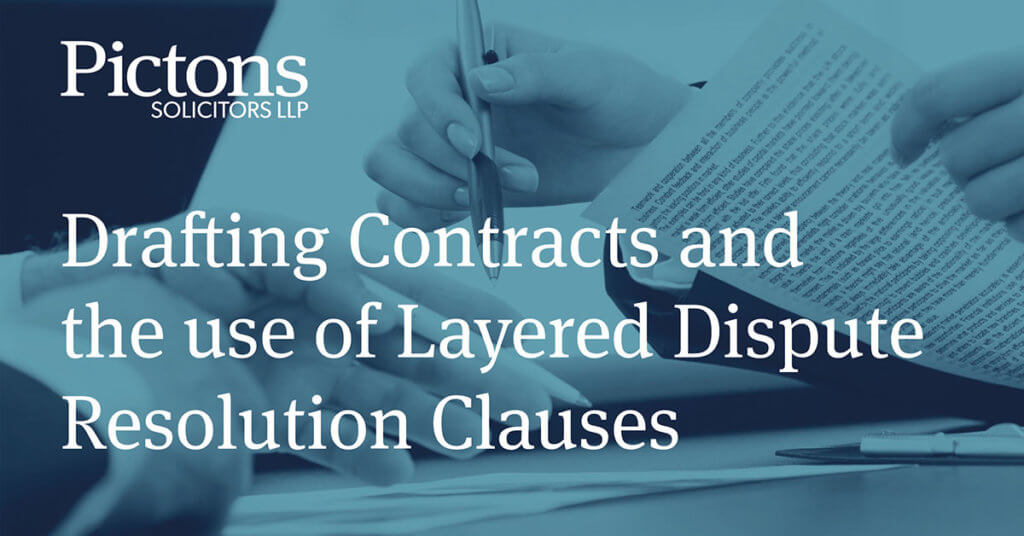Drafting Contracts and the use of Layered Dispute Resolution Clauses

A well drafted and structured commercial contract is the cornerstone of pragmatic business.
Without a contract or set of terms and conditions that are ‘fit for purpose’ and of ‘satisfactory quality’ the scope and propensity for issues and disputes to arise is immense; it’s perhaps even more alarming than that as it is probable and not just possible that parties to a poorly drafted contract or set of terms and conditions will be involved in disagreements and litigation before their commercial relationship concludes and this is not good business practice.
Getting it right from the start
Engagement is everything.
Engagement means far more than just communication. The engagement of the parties as well as their advisors from the outset should, through effective communication and intelligent negotiation will lead logically to a finalised agreement that reflects, in a more balanced fashion, the commercial intentions and needs of the parties thereby making the relationship stronger and less likely to descend into dispute.
Bespoke or template?
There is no doubt that a contract, agreement or set of terms and conditions are going to be more detailed if they have been drafted by lawyers. It would also be accurate to advance the point that agreements that have been prepared and signed without legal input and or advice can often lead to disputes over interpretation and design far more quickly.
All agreements require careful deliberation. It is neither prudent in terms of commerce nor law, to expect one contract to be a perfect fit for another, even if it appears to be identical. It is also not sensible commercial practice to sign a contract without first understanding it, but sadly both of these occur regularly and cause parties to become involved in disputes that could have, and should have, been avoided.
It is an accepted tradition that the ‘boilerplate’ clauses (the set of non-operative provisions) are often drafted and reviewed as standard and although in principle there is nothing obviously wrong with accepting the items to be included, the reliance on standard drafts is rarely a productive mechanism for an effective and successful commercial relationship.
A can of worms opened all over a legal minefield
A party who accepts the other-side’s standard contract or terms and conditions in order to avoid opening the preverbal ‘can of worms’ does so at their own peril. Many businesses want to avoid the legal minefield of contractual debate and the ‘travelling draft’ however acceptance without review or understanding may lead to a future sense of injustice and this will only expedite the escalation of disputes.
It is easy to be wistfully reflective with hindsight propounding how unfair it is when contractual terms signed and accepted are utilised to one party’s disadvantage. Court rooms are filled with parties demanding ‘justice’ and ‘fairness’ but these equitable outcomes are not always going to be possible as the Courts have declared it is not their responsibility to protect commercial parties from a bad bargain.
Prevention is therefore better than cure
It is in everybody’s long term interests if parties work together in a collaborative and open manner with regards to the formalisation of contractual terms. There will always be occasions during such discussions where elements of disagreement occur however these are part of the negotiation phase and should be embraced not feared or ignored; – after all anyone can walk-away before the agreement is signed, it is not so easy to do so after.
Layered dispute clauses
The inclusion of a bespoke layered dispute resolution clause operates as a ‘fail-safe’ mechanism in the event that a dispute emerges after the contract has been entered into. The advantages to such an inclusion are that the parties can engage in a pre-agreed set of processes to deal with any issues in a cost effective and time efficient way thereby keeping the parties focused on their operative obligations under the agreement without resorting to legal proceedings and courts.
Moreover it is also often the case that the reliance on a ‘boilerplate’ dispute resolution clause actually has no practical benefit, for example a clause that advocates the use of Arbitration, but the contractual quantum is of a minor amount to make Arbitration utterly prohibitive, is not an effective dispute resolution clause. Furthermore a construction contract that only refers to the Adjudication of disputes has palpably overlooked that Adjudication is a right under statute and therefore applied by law into the agreement.
It is therefore of paramount importance that the parties work together on the careful and suitable wording of the layered dispute resolution clause to make sure that it is ‘fit for purpose’ and will bind the parties to agree to it in the event that a dispute or disagreement arises under the over-arching agreement.
Conclusion
Whilst it might appear to be an obvious statement but ‘getting it right from the start’ has to be the aspirational objective when contracts or agreements are being prepared and drafted. Too often are the agreements or contracts rushed though because of other, often commercial, pressures or ‘we’ll deal with the fine print later on’ and it never gets done and this is not effective dispute avoidance in reality it is dispute creation and that is not commercial sensible for any business.
If you would like support with a commercial dispute or require any assistance in drafting contractual agreements please contact the Pictons team.